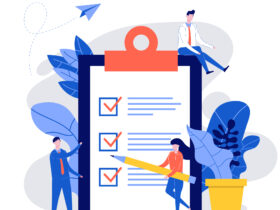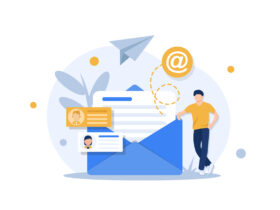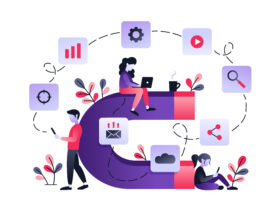Outbound marketing helps you reach customers…
…but in what ways?
As a small business owner, you know how important it is to bring in clients and explore marketing tactics. You’re also probably the type that doesn’t want to sit around waiting for them.
Outbound marketing is all about getting out there.
Here’s what to know and how to begin using outbound strategies to create success for your small business.
What is outbound marketing?
Outbound marketing is a type of marketing where a business tries to reach potential customers outside of their current contact list. This can be done through various methods such as advertising, PR, and direct sales.

Outbound marketing can be expensive and often requires a lot of resources but can be very effective in reaching a large number of potential customers.
Why use outbound marketing? Well…
Outbound marketing is often used to reach customers who are not already familiar with your business or product. It can be a great way to generate leads and build brand awareness.
Additionally, outbound marketing can be used to supplement other marketing efforts like inbound marketing or word-of-mouth marketing.
There are many benefits of outbound marketing, including:
- The ability to reach a large number of potential customers
- The ability to target specific demographics
- The ability to generate leads and build brand awareness
Of course, there are some drawbacks…
- It can be expensive
- It can be time-consuming
- It can be difficult to track results
With all that said, though, outbound marketing is extremely powerful if you know what you’re doing — the ROI on it far outweighs the drawbacks.
Must-try outbound marketing strategies
Outbound marketing strategies typically involve tactics such as advertising, public relations, and direct marketing. These methods are used to reach potential customers outside of the company, through channels such as television, radio, newspapers, magazines, or the Internet.
For small businesses…
The best outbound marketing strategy is whatever aligns with your budget, goals, and capabilities. If cold calling is your bread and butter then double down and make that your go-to. If you’re a maverick at social media and can get people talking then pour your resources into social.
Take the 80/20 route when it comes to exploring outbound marketing tactics and following through with your small business marketing plan.
Use the strategy that’s going to bring in a constant flood of leads. But, make sure you’re also taking some time to experiment with other forms.
That all said…
Here’s how to start putting some of the more popular outbound strategies to work:
1. Cold calling
Cold calling is a sales technique where you contact potential customers who are not already familiar with your business or product. It can be a great way to generate leads and build brand awareness.

When cold calling, it’s important to remember a few key things:
1. Do your research
Before you pick up the phone, make sure you know as much as possible about the potential customer. This includes their business, the industry they’re in, and what challenges they may be facing.
2. Script your call
Make sure you have a clear idea of what you want to say before you make the call. This will help keep you focused and ensure that you cover all the key points.
3. Be prepared for objections
Customers will often raise objections during a cold call. Be prepared to answer them and don’t let them throw you off track.
4. Stay positive
It can be tough to stay positive when you’re getting rejected all the time, but it’s essential to keep your energy up if you want to close any deals.
5. Follow up
Make sure you follow up with any leads that you generate during a cold call. This will help keep them top of mind and increase your chances of closing the deal.
2. Advertising
Advertising is a form of outbound marketing where businesses pay to have their message placed in front of potential customers. It can be an effective way to reach a large number of people and generate leads.

When advertising, there are a few key things to keep in mind:
Keep it simple
Your ad should be clear and concise. Don’t try to cram too much information into it or you’ll lose the reader’s attention.
Call to action
Your ad should have a strong call to action that compels the reader to take the next step. This could be visiting your website, signing up for a free trial, or making a purchase.
Test and measure
Always test and measure your ads before you launch them. This will help you fine-tune them and ensure that they’re as effective as possible.
The thing about advertising…
…is that it can either go great or have you in shambles.
We wholly recommend doing a small campaign to test the waters before dumping money into a big campaign. This will let you refine your message without burning through the ad budget. Then, once you’re comfortable with the platform and got a winning ad — crank up the spending and start reaching your audience!
3. Public relations
Public relations is a form of outbound marketing where businesses try to generate positive media coverage for their company or product. This can be an effective way to build brand awareness and credibility.

When doing public relations, there are a few key things to keep in mind:
1. Build relationships
It’s important to build relationships with members of the media. This will make it more likely that they’ll be interested in your story and willing to cover it.
2. Pitching
When pitching your story to the media, make sure you’re clear and concise. Don’t try to cram too much information into your pitch or they’ll lose interest.
3. Follow up
Always follow up with members of the media after you’ve pitched them a story. This will help keep your story top of mind and increase your chances of getting coverage.
4. Monitoring
Monitor your media coverage and track how it’s impacting your business. This will help you adjust your strategy and ensure that you’re getting the most bang for your buck.
4. Social media
Social media is a form of outbound marketing where businesses use platforms like Facebook, Twitter, and LinkedIn to build relationships with potential and current customers. It can be an effective way to connect with a large number of people and generate leads.

When doing social media, there are a few key things to keep in mind:
Be consistent
It’s important to be consistent with your social media activity. If you’re only posting sporadically, you’re not likely to see many results.
Be engaging
Make sure your posts are engaging and interesting. No one wants to read a long, boring post. Keep it short and sweet instead.
Use images
Images are more likely to catch someone’s attention than text alone. Make sure you’re using them in your posts to increase engagement.
One of the easiest ways to get started with social media — in an outbound sense — is to hop on LinkedIn.
LinkedIn is probably the best platform for small businesses…
…because you’re connecting with people that make business decisions (aka. $$$$$).
A simple message can do the trick but a better strategy is finding ways to help others. Tune in to what people need and pop in with a solution or aid when they need it. This gets you on their radar and can lead to follow-ups (and possibly some sales!)
5. Email marketing
Email marketing is a form of outbound marketing where businesses send emails to potential and current customers. It can be an effective way to build relationships and generate leads.

An email list is a great way to keep in touch with your customers and build a relationship with them. Here are some tips on how to create an email list:
1. Use a sign-up form on your website or blog. Make it easy for visitors to sign up by including the form in a prominent location on your site.
2. Offer an incentive for signing up, such as a discount or free shipping on their next purchase. This will help increase the number of people who sign up.
3. Add a link to your sign-up form in your email signature. This will remind customers to sign up every time they see your email.
4. Send regular updates to your email list, highlighting new products, special offers, and other newsworthy items. This will keep subscribers engaged and coming back for more.
Email marketing lets you easily stay in touch with your customers and grow your business.
A truly great email list is something worth sharing, too.
You may find that your email marketing efforts become one of the main drivers of revenue. All you need to do is drop in an email from time to time and drum up interest in what you’re doing. You can also leverage the connections to reach more people by way of sharing, or having others essentially “crowdsource” your outreach efforts with their participation.
Outward and Outbound!
Outbound marketing is a great way to connect with potential customers and generate leads.
But…
You do need to get out of your comfort zone and actually get out there.
Your customers are waiting.
Use the strategies outlined in this guide to reach them.
So there you have it! A basic guide to outbound marketing for small businesses. Now get out there and start marketing!























Leave a Reply